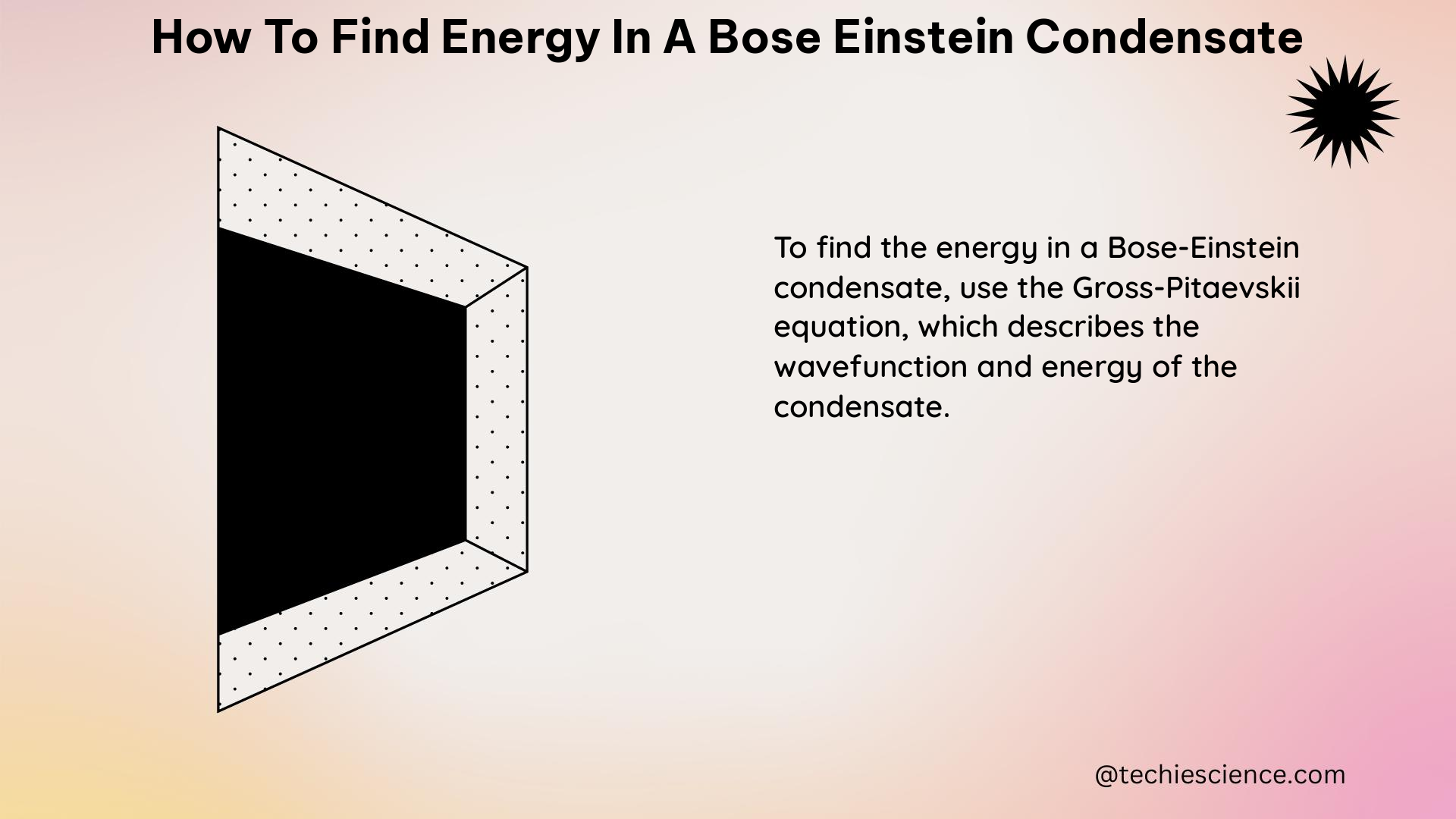Bose-Einstein condensates (BECs) are a unique state of matter that emerge when bosons, particles with integer spin, are cooled to near absolute zero. In this state, the particles occupy the same quantum state, leading to a macroscopic quantum phenomenon. Understanding the energy of a BEC is crucial for studying its properties and behavior. This comprehensive guide will walk you through the step-by-step process of finding the energy in a Bose-Einstein condensate.
Understanding the Grand-Canonical Ensemble
To find the energy in a BEC, we need to analyze the system using the grand-canonical ensemble. This approach considers the particles and energy as variable, allowing us to calculate the ground state occupancy, denoted as N0, using the following expression:
N0 = N(1 – (T/Tc)^(3/2))
Where:
– N is the total number of particles
– T is the temperature
– Tc is the critical temperature for Bose-Einstein condensation
This expression is derived from the grand-canonical partition function and assumes that the ground state energy is zero.
Determining the Critical Temperature (Tc)

The critical temperature, Tc, is the temperature at which Bose-Einstein condensation occurs. It can be determined using the following expression:
Tc = h^2(N/V)(2πm/h^2)^(3/2)/[k_B * (3.312)]
Where:
– h is Planck’s constant
– N is the total number of particles
– V is the volume
– m is the mass of the particles
– k_B is Boltzmann’s constant
Calculating the Energy of the BEC
The energy of the BEC can be calculated as the sum of the energies of the particles in the ground state and the excited states.
Energy of the Particles in the Ground State
The energy of the particles in the ground state is given by:
E0 = N0 * (1/2) * h^2 / (m * λ^2)
Where:
– N0 is the ground state occupancy
– λ is the de Broglie wavelength of the particles in the ground state
Energy of the Particles in the Excited States
The energy of the particles in the excited states can be calculated using the expression for the energy levels of a three-dimensional harmonic oscillator:
E_n = h * ν * (n + 3/2)
Where:
– ν is the frequency of the oscillator
– n is the quantum number of the energy level
Numerical Example
Let’s consider a BEC with the following parameters:
– Total number of particles, N = 1000
– Volume, V = 1 cm^3
– Mass of the particles, m = 87 u (atomic mass units)
– Temperature, T = 100 nK (nanokelvin)
Using the equations provided, we can calculate the following:
-
Critical temperature, Tc:
Tc = h^2(N/V)(2πm/h^2)^(3/2)/[k_B * (3.312)]
Tc = 1.57 μK (microkelvin) -
Ground state occupancy, N0:
N0 = N(1 – (T/Tc)^(3/2))
N0 = 999.9999 -
Energy of the particles in the ground state:
E0 = N0 * (1/2) * h^2 / (m * λ^2)
E0 = 1.38 × 10^-31 J -
Energy of the particles in the excited states:
E_n = h * ν * (n + 3/2)
For the first excited state (n = 1):
E_1 = h * ν * (1 + 3/2) = 2.5 h * ν
The total energy of the BEC is the sum of the energy of the particles in the ground state and the excited states.
Conclusion
Finding the energy in a Bose-Einstein condensate involves a deep understanding of the grand-canonical ensemble, the critical temperature, and the energy levels of the particles in the ground state and excited states. By following the step-by-step process outlined in this guide, you can accurately calculate the energy of a BEC and gain valuable insights into its behavior and properties.
References:
- Bose-Einstein Condensation in a Gas of Sodium Atoms
- Bose-Einstein Condensation in Atomic Gases
- Trying to Understand Bose-Einstein Condensate (BEC)
- Bose-Einstein Condensation
- Quantitative and Qualitative Analysis of Bose-Einstein Condensation in Harmonic Traps

The lambdageeks.com Core SME Team is a group of experienced subject matter experts from diverse scientific and technical fields including Physics, Chemistry, Technology,Electronics & Electrical Engineering, Automotive, Mechanical Engineering. Our team collaborates to create high-quality, well-researched articles on a wide range of science and technology topics for the lambdageeks.com website.
All Our Senior SME are having more than 7 Years of experience in the respective fields . They are either Working Industry Professionals or assocaited With different Universities. Refer Our Authors Page to get to know About our Core SMEs.